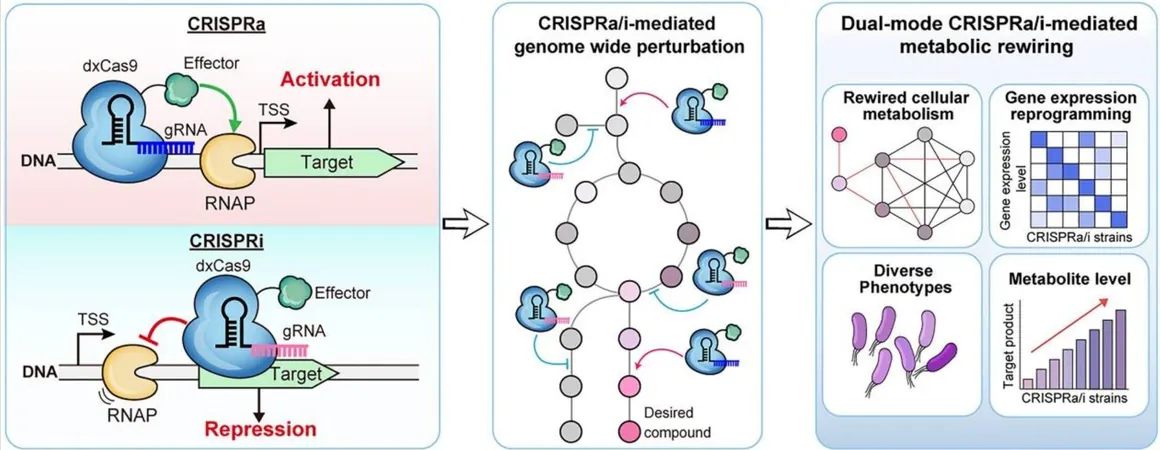
Revolutionary Dual-Mode CRISPR: The Key to Controlling Genes Like Never Before!
2025-09-22
Author: Siti
Unlocking Genetic Control
Imagine flipping a switch to control genes in a cell—turning them on to boost production or off to restrict it. Researchers in Korea have just shattered the confines of traditional CRISPR technology with an unprecedented system that can simultaneously activate and deactivate genes. This groundbreaking development promises to transform synthetic biology, paving the way for innovative applications in the bio-industry.
A Game-Changing Discovery
Under the guidance of Professor Ju Young Lee from KAIST and Dr. Myung Hyun Noh from KRICT, a pioneering dual-mode CRISPR system has been crafted to work its magic in E. coli. Published in the prestigious journal Nucleic Acids Research, this advancement allows for unprecedented precision in gene manipulation.
Why E. coli?
E. coli is a versatile microorganism, frequently used in laboratory experiments due to its simplicity and rapid multiplication. It serves as a living laboratory, capable of being tailored to produce various valuable substances - making it an ideal candidate for the cutting-edge applications of CRISPR.
Engineering Life at the Genetic Level
At the heart of synthetic biology lies the design of genetic circuits—much like programming a computer—where certain genes are activated while others are suppressed. The newly developed dual-mode CRISPR acts as precise "gene scissors," facilitating this intricate regulation.
Overcoming Existing Limitations
Previously, CRISPR tools were mainly focused on gene repression, with limited capabilities for activation. Existing systems required specific DNA sequences (PAMs), which restricted their effectiveness. The new dual-mode CRISPR not only broadens the target range for gene editing but significantly enhances activation performance, particularly in bacterial systems where earlier methods faltered.
Staggering Results
This innovative technology demonstrated remarkable results! In activation tests, expression levels soared by up to 4.9 times, while repression capabilities reached an impressive 83%. The ability to control two genes at once is particularly astonishing, achieving an 8.6-fold activation of one gene coupled with a 90% repression of another.
A Leap Forward in Production
To showcase the practicality of this technology, the research focused on 'violacein', a purple pigment renowned for its anticancer properties. By manipulating the genes associated with its production, they achieved a monumental increase: 2.9 times when activating 'rluC' and 3.0 times when repressing 'ftsA'. The simultaneous control led to a staggering 3.7-fold production boost.
Future Implications
Dr. Noh emphasized the significance of enabling precise gene activation in bacteria, heralding a new era for synthetic biology in bio-industry development. Professor Lee echoed this sentiment, highlighting the powerful synergy of combining gene editing with synthetic biology, unleashing the potential for efficient microbial production systems.
Broad Applicability
With successful applications in other bacterial species, this revolutionary technology holds promise across various industries, including biopharmaceuticals, biochemicals, and biofuels. As Dr. Soo Young Moon leads the charge in further research, the potential benefits to science and industry become increasingly clear.



 Brasil (PT)
Brasil (PT)
 Canada (EN)
Canada (EN)
 Chile (ES)
Chile (ES)
 Česko (CS)
Česko (CS)
 대한민국 (KO)
대한민국 (KO)
 España (ES)
España (ES)
 France (FR)
France (FR)
 Hong Kong (EN)
Hong Kong (EN)
 Italia (IT)
Italia (IT)
 日本 (JA)
日本 (JA)
 Magyarország (HU)
Magyarország (HU)
 Norge (NO)
Norge (NO)
 Polska (PL)
Polska (PL)
 Schweiz (DE)
Schweiz (DE)
 Singapore (EN)
Singapore (EN)
 Sverige (SV)
Sverige (SV)
 Suomi (FI)
Suomi (FI)
 Türkiye (TR)
Türkiye (TR)
 الإمارات العربية المتحدة (AR)
الإمارات العربية المتحدة (AR)